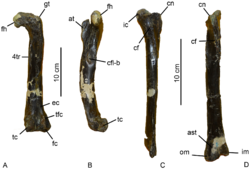Aniksosaurus
|
Aniksosaurus Temporal range: Late Cretaceous |
|
|---|---|
 |
|
| Right femur (MDT-PV 1/3) and right tibia (MDT-PV 1/48) | |
| Scientific classification | |
| Kingdom: | Animalia |
| Phylum: | Chordata |
| Class: | Reptilia |
| Superorder: | Dinosauria |
| Order: | Saurischia |
| Suborder: | Theropoda |
| (unranked): | Coelurosauria |
| Genus: | Aniksosaurus |
| Binomial name | |
|
Aniksosaurus darwini Martínez & Novas, 2006 |
|
Aniksosaurus (meaning "spring lizard", from Modern Greek Άνοιξη, "Spring", referring to the fact it was found on 21 September 1995, the onset of Spring on the Southern Hemisphere) is a genus of dinosaur from what is now present-day Chubut Province, Argentina. It was a theropod, specifically a coelurosaur, which lived in the middle Cretaceous period, between 96-91 million years ago. The type species, Aniksosaurus darwini, was formally described by Rubén Dario Martínez and Fernando Emilio Novas in 2006; the name was first coined in 1995 and reported in the literature in 1997. The specific epithet honors Charles Darwin who visited Patagonia in 1832/1833 during the Voyage of the Beagle.
The type specimen MDT-PV 1/48, discovered in the Bajo Barreal Formation, consists of an articulated right hindlimb, which includes the femur, fibula, tibia and foot. The longest femur discovered for this genus measures 247mm, and the longest tibia, 270mm. On average, the tibia is 13% longer than the femur in Aniksosaurus, an adaptation which has been strongly correlated with the development of cursorial habits in dinosaurs. Martinez and Novas (2006), based on femoral measurements, originally suggested that Aniksosaurus darwini was approximately 2 m (7 ft) long and 70 cm (2 ft) tall at the hip, and weighed up to 65 kilograms (143 pounds). However, recent estimates suggest a total body length between 2 m (7 ft) and 3 m (10 ft) and a body weight between 35 kilograms (77 pounds) and 45 kilograms (99 pounds). In a 2013 study by Ibiricu et al., it was concluded that the holotype and four more individuals referable to Aniksosaurus, were juvenile to sub-adult individuals as shown by a histological analysis. The two individuals analyzed had histological characteristics that suggested an approximate age of three. The morphological evidence supporting ontogenetic immaturity was as follows: (a) the absence of an outer circumferential layer; (b) the absence of secondary (Haversian) osteons; (c) the presence of only a few growth cycles; and (d) the thickness of the zones.
...
Wikipedia
